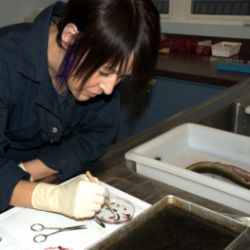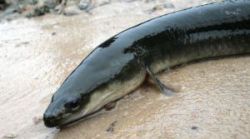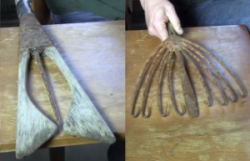Halifax Media Co-op
News from Nova Scotia's Grassroots
Mi’kmaq traditional knowledge: Eels and the Bras d’Or Lakes, by Shelley Denny
This blog was originally posted at Small Scales, the excellent East Coast fisheries blog administered by the Marine Issues Committee of the Ecology Action Centre. Follow the always interesting Marine Issues Committee on Twitter.
I must admit that my first introduction as a young girl to eels was full of awe. Slimy eels, squirming in the kitchen sink, were given to my grandmother, Isabel. “Kataq” she said, “eels”. I watched as she cleaned eels and removed the skin from the thinner ones with ease and kept the skin on the fatter ones before freezing them. What wasn’t frozen was taken to the back yard for the birds. Fish was on our menu every Friday so our freezer was full of fish given to her. Anytime fish, deer, moose or rabbit were given to my grandmother, she was ecstatic and very grateful. It was better than Christmas for her.
My first encounter with eels in the local brook was similar, but more terrifying. As children we would entertain ourselves with catching minnows and water spiders in a shallow brook that ran beside our home. Someone yelled “katew!” and we scrambled to get out of the brook as fast as we could. “How big is it?” and “Did it bite you?” were all we could think to ask each other. I excitedly told my grandmother we found an eel in the brook, as this was the first time I had seen one in the water. She told me that sometimes they are in the brook but that is not where we catch them. “Do you want us to catch it for you?” I asked, knowing how pleased she was to get eels. She replied in Mi’kmaq that it wasn’t necessary. Eels were still in the freezer.
I was curious about eels. I looked them up in an encyclopedia of life my uncle had “borrowed” from our band office (I returned it, 20 years after it had originally been borrowed).There were so many eels in the book and I couldn’t tell which one we one was in our brook. My grandmother looked at the photos and pointed out the correct one. Ahh, I thought. Not just any eel. The American eel. Katew.
Many moons have passed before eels came back into my life. Encouraged to attend university by my grandmother, I studied biology and later fisheries ecology. There is only so much information you can get from the encyclopedia or documented scientific fact. Much more can be found in the experience and teachings of the Mi’kmaq and other First Nations who have a long-standing relationship dating back 4000 years or more. It is my honor to have been involved in the collection and documentation of traditional knowledge of eels in the Bras d’Or Lakes, Nova Scotia, and important fishing area for traditional fisheries for Mi’kmaq communities on Cape Breton Island.
Traditional knowledge is living knowledge, continually adapting based on the experience of today and lessons of the past. A traditional perspective on Canada’s ever growing list of species considered for protection under the Species at Risklegislation can provide complementary knowledge to address gaps in scientific knowledge, stock status, and management. This is the case for eels.
In order to understand how Mi’kmaq posses such knowledge, it is important to understand the relationship of Mi’kmaq to the eel. This relationship is one of reverence and holds as special place in Mi’kmaq spirituality. Eels and all living and non-living objects posses a spirit. The eel in particular was offered to Klooscap, the Creator for a successful hunt and as thanks. The eel was not wasted or over-exploited. The Mi’kmaq practiced “take what was needed” ethic. Eels were reserved for ceremonies and feasts and are important during mid-winter feasts as an offering for surviving another harsh winter.
The cultural significance of the eel is difficult to articulate but the importance of eels to the Mi’kmaq is evident in the language. There are Mi’kmaq words for how eel is prepared, tools for fishing, and even eel slime has a name! Often eels were the only source of food during winter and have been consumed three times a day for days to weeks. Elder Albert Marshall feels that the value of the eel would be better described in the form of a question: “What would our lives be like without the eel?” It is unimaginable.
Eel is used for first and foremost as food. It is a dependable source of food that is available year round. There is a sustenance fishery on the East Coast of Canada by the Mi’kmaq. Although many Mi’kmaq communities have commercial eel licenses, they do not use them as many harvesters noticed that it wasn’t as easy to catch a feed of eels in an area that is commercially fished. The timing of eel fishing coincides with cues from nature. Frogs, lightening bugs and gaspereau run are often used as signals that eels are available for harvest. Heavy rains in October indicate that the eel is preparing to over winter.
Traditionally, eels were captured in weirs in rivers but eels are harvested in the Bras d’Or Lakes is using spears. Eels swim and inhabit different bottoms and the Mi’kmaq had created tools to reflect eel this. There are spears for soft bottom and hard bottom, nikoql. These spears are used when on a boat in shallow water usually in the evening but if the conditions are calm and without glare on the water, eels can be speared during the day. When spearing at night or during the day, eels are selected for their size. Winter spearing takes place through the ice using the winter spear, natawemkewe’l, on soft bottom. As eels are not visible, eels that are speared are kept even if they are under 45 cm. It is the belief that eels offer themselves to the harvester by wrapping themselves around the spear so it can be taken. If this does not occur, then the eel may fall off and may die due to injuries and the harvester wasted the eel.
Eel preparation is important to maintain the quality of the meat. The kidney and main artery must be removed or it will taint the taste of the meat. Common preparations are eel stew, katawapu’l, or as pqwasaw, filleted eels which are baked. Eel stew is made with smaller, thinner and skinned eels, 45 cm to about 60 cm, while bake eels are made with larger and fatter eels that have not been skinned. Large eels are also hung and dried. Those who eat eels report a calm and relaxing effect. Eel stew is requested as a last meal to ease the transition to the spirit world.
The skin is used for boots/moccasin soles, ties, bindings, crafts, and to stabilize sprains or broken bones. The tail is used for bait for other fisheries. The skins were also used as fat to cook other foods and as medicine. Oil from larger eels was used to treat ear infections and loosen ear wax. Oil was added to baby bottles for extra nutrition and to help children develop a taste for eels. The parts of the eel that are not used are given back to Mother Earth as an offering to birds or buried in the earth as a sign of gratitude.
Traditional management of eels is guided by Mother Nature. The availability of eels determines the harvest. Also important are environmental variables such as weather which can impact water visibility or ice formation. Fishing method offers protection to eels. Spearing can only take place in shallow depths.
Eel harvesters practice rotational fishing and customarily wait five to seven days before returning to a previously fished area. Freshwater habitats are not targeted for our communities and serve as refuge areas. Eels of a certain size are fished. Smaller eels are not taken as they do not feed as many people and more eels, thus eel spirits, will have to be taken. In the winter months, harvesters adjust the thrust of their spear to select a balance between smaller and larger eels that are known to bury deeper in the mud. There are times during the year when eels are not fished such as during the blueberry harvest in August.
We are fortunate that the Mi’kmaq still harvest eels but the number of eels in the Bras d’Or Lakes are not as plentiful as they once were. Overall, it takes more time to catch the same amount of eels than it did 20 to 30 years ago. It takes longer to put food on our table. Mother Nature is out of balance. Her waters are tainted from land activities, pollution, run-off and acid rain. Commercial fisheries for eels continue while declines are evident and many eels are prevented from reaching their spawning ground. Invasive species are affecting our eels with unknown consequences survival, migration and reproduction.
The most important lesson of traditional knowledge is that we adapt based on today’s experience and lessons from the past, and we do it quickly. We know that commercially fished species can fail to return to previous levels even with moratoriums. We cannot bring back the eel if we do not improve eel habitat and lessen commercial and recreational harvest at all levels.
Waste must be prevented. Does science really need large sample sizes? To save our eels, we must work together, on all areas that are impacting our eels, and do so quickly.
Shelley Denny, originally from Chapel Island First Nation, Nova Scotia, works as the Director of Research and Stewardship for the Unama’ki Institute of Natural Resources in Eskasoni. She currently lives in Eskasoni with her husband and 3 children.
The site for the Halifax local of The Media Co-op has been archived and will no longer be updated. Please visit the main Media Co-op website to learn more about the organization.





